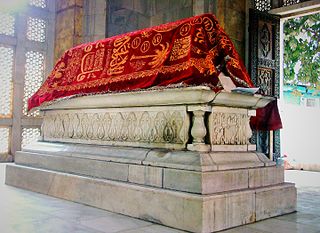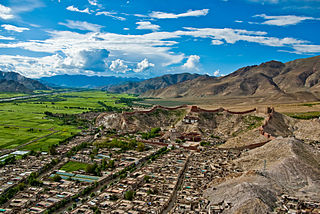
Mu'izz ad-Din Muhammad ibn Sam, also known as Muhammad of Ghor or Muhammad Ghori, was a ruler from the Ghurid dynasty based in the Ghor region of what is today central Afghanistan who ruled from 1173 to 1206. Muhammad and his elder brother Ghiyath al-Din Muhammad ruled in a dyarchy until the latter's death in 1203. Ghiyath al-Din, the senior partner, governed the western Ghurid regions from his capital at Firozkoh whereas Muhammad extended Ghurid rule eastwards, laying the foundation of Islamic rule in South Asia, which lasted after him for nearly half a millennium under evolving Muslim dynasties.

Shams ud-Din Iltutmish was the third of the Mamluk kings who ruled the former Ghurid territories in northern India. He was the first Muslim sovereign to rule from Delhi, and is thus considered the effective founder of the Delhi Sultanate.

Qutb ud-Din Aibak, was a general of the Ghurid emperor Muhammad Ghori. He was in charge of the Ghurid territories in northern India, and after Muhammad Ghori's assassination in 1206, he established the Delhi Sultanate (1206–1526), and started the Mamluk dynasty, which would rule the Sultanate until 1290.

The Mamluk dynasty, also known as Slave dynasty, was a dynasty which ruled Delhi Sultanate from 1206 to 1290. It was the first of five largely unrelated dynasties to rule the Delhi Sultanate until 1526. Before the establishment of the Mamluk dynasty, Qutb al-Din Aibak's tenure as a Ghurid dynasty administrator lasted from 1192 to 1206, a period during which he led forays into the Gangetic plain and established control over some of the new areas.

The Sena dynasty was a Hindu dynasty during the early medieval period on the Indian subcontinent, that ruled from Bengal through the 11th and 12th centuries. The empire at its peak covered much of the north-eastern region of the Indian subcontinent. The rulers of the Sena Dynasty traced their origin to the south Indian region of Karnataka.
The Ghurid dynasty was a Persianate dynasty of presumably eastern Iranian Tajik origin, which ruled from the 8th-century in the region of Ghor, and became an Empire from 1175 to 1215. The Ghurids were centered in the hills of the Ghor region in the present-day central Afghanistan, where they initially started out as local chiefs. They gradually converted to Sunni Islam after the conquest of Ghor by the Ghaznavid ruler Mahmud of Ghazni in 1011. The Ghurids eventually overran the Ghaznavids when Muhammad of Ghor seized Lahore and expelled the Ghaznavids from their last stronghold.

Gauḍa is a historic city of Bengal in the eastern part of the Indian subcontinent, and one of the most prominent capitals of classical and medieval India, being the capital city of Bengal under several kingdoms. The Gauḍa region was also a province of several pan-Indian empires. During the seventh century, the Gour Kingdom was founded by King Shashanka, whose reign corresponds with the beginning of the Bengali calendar. Gour gradually became synonymous with Bengal and Bengalis. It was conquered by Bakhtiyar Khalji, a lieutenant of the Ghurid ruler Muhammad of Ghori in 1203.

Nasir ud din Mahmud Shah was the eighth sultan of the Mamluk Sultanate. The Tabaqat-i Nasiri, written by the court historian Minhaj-i-Siraj, is dedicated to him. His father-in-law Ghiyas ud din Balban handled the state affairs during his reign.

Ikhtiyār al-Dīn Muḥammad Bakhtiyār Khaljī, also known as Bakhtiyar Khalji, was a Turko-Afghan military general of the Ghurid ruler Muhammad of Ghor, who led the Muslim conquests of the eastern Indian regions of Bengal and Bihar and established himself as their ruler. He was the founder of the Khalji dynasty of Bengal, which ruled Bengal for a short period, from 1203 to 1227 CE.
Lakshmana Sena or Lakshman Sen was the ruler from the Sena dynasty of the Bengal region on the Indian subcontinent. His rule lasted for 28 years.

Rukn ad-Dīn ʿAlī Mardān Khaljī was a 13th-century governor of Bengal, a member of the Khalji dynasty of Bengal.

Ḥusām ad-Dīn ʿIwaz bin Ḥusayn Khaljī, later known by his regnal title as Ghiyāth ad-Dīn ʿIwaz Shāh, was a two-time governor of Bengal under the Delhi Sultanate, and a member of the Khalji dynasty of Bengal. During his second term, lasting from 1212 to 1227, Khalji declared himself as an independent ruler of Bengal.
Muḥammad Shīrān Khaljī, or simply Shiran Khalji, was the second governor of the Khalji dynasty of Bengal, based in Lakhnauti, Bengal, from 1206 until 1208.
The First Battle of Tarain, also spelt as the First Battle of Taraori, was fought in 1191 between the invading Ghurid army led by Muhammad of Ghor and the Rajput Confederacy led by Prithviraj Chauhan, near Tarain. The battle ended in decisive victory for the Rajputs; however, Muhammad of Ghor managed to escape and returned to Ghazni.
Tabaqat-i Nasiri, named for Sultan Nasir-ud-Din, is an elaborate history of the Islamic world written in Persian by Minhaj-i-Siraj Juzjani and completed in 1260. Consisting of 23 volumes and written in a blunt straightforward style, Juzjani devoted many years to the creation of this book even providing references for his information. Although a large portion of the book is devoted to the Ghurids, it also contains a history of the predecessors in Ghazna before the Ghaznavid Sebuktigin took power. In compiling his Tabaqat i Nasiri, Juzjani used other books now lost; part of Baihaqi's reign of Sebuktigin, Abu'l-Qasim Imadi's Ta'rikh-i mujadwal and most likely Ibn Haisam's Qisas-i thani. Juzjani's "tabaqat" would initiate the form of writing for dynastic history in centuries to come.

Bakhtiyar Khalji, the general of Qutubuddin Aibak, launched a campaign to invade Tibet in the 13th century.
The Khalji dynasty was the first Muslim dynasty to rule Bengal. The dynasty, which hailed from the Garmsir region of present-day Afghanistan, was founded in 1204 by Muhammad Bakhtiyar Khalji, a Muslim Turko-Afghan general of the Ghurid Empire. The Khaljis initially pledged allegiance to Sultan Muhammad of Ghor until his death in 1206, though their rule in Bengal was mostly independent. Under the rule of Iwaz Khalji, Bengal experienced major developments such as its first naval force, flood defence systems and linkage with the Grand Trunk Road. The dynasty was based in the city of Lakhnauti in northern Bengal, later expanding eastwards and southwards. Nasiruddin Mahmud, the son of Mamluk sultan Iltutmish of Delhi managed to conquer Bengal in 1227; although the Khaljis briefly reasserted their independence, they surrendered to the Mamluks in 1231, who replaced them with a series of regional governors.
Raja Prithu was a warrior king of the early medieval period in the present-day state of Assam, India and Bangladesh. Archeological remains of a Shiva temple and extensive fortifications in present-day Jalpaiguri in India and present day Rangpur District of Bangladesh are attributed to him.

ʿAlī Sher bin ʿIwaz Khaljī was a former governor of northwest Bengal (Birbhum) serving under his father, Sultan Iwaz Shah of the Khalji dynasty of Bengal. His name finds mention in the earliest known stone inscription mentioning a Muslim ruler of Bengal.

The Ghurid campaigns in India were a series of invasions for 31 years (1175–1206) by the Ghurid ruler Muhammad of Ghor in the last quarter of the twelfth and early decade of the thirteenth century which lead to the widespread expansion of the Ghurid empire in the Indian subcontinent.













